The impact of the COVID-19 pandemic on the economy and commercial vehicle equipment demand was sudden and extreme. And while the late-2020 rebound was welcomed, it could be a “fairly long slog back” to 2019 levels for the CV markets, explained Steve Latin-Kasper, NTEA senior director of market data and research.
In an online presentation Jan. 12, “Understanding work truck industry 2021 market dynamics,” Latin-Kasper opened with a chart that showed a year-over-year drop in US GDP of more than 30% in the second quarter of 2020, followed by corresponding rebound in Q3, and he called the anomalous fall and rise “the graphic representation of what a pandemic looks like.”
“We have not seen a downturn to the extent that we saw in the second quarter of 2020 since the 1930s. And we have never seen an upturn to the extent that we saw in the third quarter as we bounced back from it,” Latin-Kasper said. “The run up to World War II, when the military-industrial complex turned the manufacturing sector back on after 10 years of depression, didn't even reach quarterly highs as large as we saw in the third quarter of this year.”
Indeed, the broader economy is getting back to “something that looks almost normal,” in macroeconomic terms. However, Latin-Kasper cautioned against the possibility of a “double-dip” recession, pointing to still-troubling employment data, tied to COVID-19 infection rates and business shutdowns.
“So we have a ways to go before we climb our way back out of this. And as of right now, it's looking like we'll be well into February or March before we will be able to say that in economic terms,” he said. “From a public health perspective, normal is going to take even longer than that to get back to—depending on how fast we can ramp up delivery of the vaccines.”
For the work truck industry, Latin-Kasper put the pandemic price tag at $30 billion in 2020, with OEMs absorbing two-thirds of the hit. Looking forward, the forecast calls for a market rebound of about 10% year-over-year in terms of unit sales, translating to a 12% bounce in revenue, totaling $141 billion compared to $126 billion in 2020. However, 2021 will still trail 2019’s $156 billion revenue total by about 10%.
Chassis, trailers
US/Mexico shipments of light- and medium-duty box-off chassis, which had steadily increased since 2010 to nearly 33,000 units per month, fell to about 25,000 units per month at the low point in 2020 before turning around slightly in Q3.
“Clearly on our way back up, we expect the fourth quarter [2020] for commercial truck sales to be much better than it was in the third,” Latin-Kasper said. “That growth rate may decelerate a bit in the first quarter [of 2021]. There are some supply chain issues; we'll see how that goes.”
He pointed to recent shortages of the computer chips used in cars and trucks as a Q1 problem that “should be temporary.”
Box-off chassis shipments of Class 8 trucks and tractors fared even worse in 2020, with monthly totals falling from about 26,000 units in 2019 to about 15,000 units in the third quarter of 2020, down more than 40%.
“We expect to see the trough occur in the next month or two in terms of year-to-year percent change,” Latin-Kasper said. “And the climb back in Class 8 will likely be faster at a higher rate of growth than in the Class 2-7 segments of the market.”
The NTEA analysis also compared shipments to sales. Latin-Kasper noted that the light- and medium-duty chart for this comparison featured Classes 2-5, with Class 6 pushed into the heavy-duty chart.
“The economic dynamics that are influencing sales and shipments activity in the commercial trucking industry right now are having much more of an impact on Classes 2-5,” he said. “And the primary reason for that is basically three words: last mile delivery.”
Indeed, sales outpaced shipments through 2018 before flipping in 2019. Beginning in the spring of 2020, the lines crossed again as sales recovered but shipments plummeted early in the pandemic before leveling off through the summer and then growing in the fall.
For heavy-duty trucks, sales and shipments tracked much more closely in the 2018-2019 period, although shipments did lag sales at a somewhat great rate during 2020.
Commercial van sales also took a tumble in 2020, although the year-over-year comparison was somewhat skewed by a massive van order from Amazon in early 2019 that drove a spike in the sales count through October. After hitting bottom at the end of Q1, van sales soon were “back on trend”. Similarly, van shipments likewise fell to almost 0 units in April 2020 due to the pandemic, but quickly recovered, according to the NTEA data.
“In fact, the current trend is moving faster than it was through 2019,” Latin-Kasper said. “So we're looking for good things to continue happening in the commercial van segment of the industry.”
For trailer production, the NTEA analysis showed a steep decline in production that began in 2019 and rapidly accelerated through 2020, mirroring the freight shipments curve from American Trucking Associations data.
“If you've been following the industry news, you already know that trailer orders are near record levels as of November and December, and that's expected to continue in January,” Latin-Kasper said. Those order levels should stabilize and, in fact, start falling in the near future. Those orders are mostly placed as a result of fleets realizing that the level of freight has already increased substantially.”
Inputs
Looking a producer price indices, Latin-Kasper suggested that global steel pricing, which had been in a gradual slide since mid-2018, began to climb in the 2020 second quarter as China—now the world’s largest steel consumer—recovered from its pandemic slowdown and is on pace for 6-7% GDP growth.
“Commodity pricing is global, so we're seeing prices go up,” he said. “But know that they could keep growing at this trend through the rest of 2021 and it will take that long to get to [2018] levels. Chances are, they aren't going to just keep going up. As the price increases, there will be incentive for a lot of unused [steel production] capacity to reopen.”
But while steel pricing is relatively stable, other commodities have shown significant swings through the pandemic and recovery. Aluminum prices, which also peaked in 2018, fell sharply through the first half of 2020 before spiking. Latin-Kasper noted the aluminum market has been more volatile than steel because there was not the same level of pre-pandemic overcapacity to create a supply buffer.
“But, once again, this is more about China than it is about anything else,” he said. “They're the world's largest consumer of aluminum—so [the price] is already stabilizing. It’s highly unlikely we get back to those 2018 peaks in 2021, and we can all plan accordingly.”
Leading indicators
In a look at leading indicators, Latin-Kasper pointed out that housing starts had begun to outpace business truck production before the pandemic; and while housing fared relatively well during 2020, truck production cratered. Based on historical trend, that resulting gap will mean a period of rapid acceleration in the rate of truck production.
“The housing start [data] series gives us a pretty good idea of timing of troughs and peaks in the commercial truck sales cycle,” he said. “We won't see the next peak in our cycle until it crosses the housing starts cycle, which probably won't occur until sometime towards the end of 2022 on current trend. And that usually gives us about a year's worth of warning. So we do not expect to see another downturn in commercial truck sales until sometime beyond 2025.”
More broadly, Latin-Kasper noted the consensus GDP forecast calls for about 4% growth to end 2020, with a deceleration in Q1 2021, but some growth is likely.
According to the National Association for Business Economics, which forecast GDP growth of 3.8% in 2021, the outlook for personal consumption expenditures, nonresidential fixed investment and residential investment is positive; government spending and consumer pricing are worrisome, and unemployment will remain high compared to the pre-pandemic records lows, coming in 6.3% in 2021.
For NTEA’s own outlook:
Pros
- Credit availability good
- Inflation remains moderate
- Historically low interest rates
- Residential construction growing
- Last mile delivery
- Federal infrastructure bill?
- Chassis availability
Cons
- Labor market imbalances
- COVID-19 remains an issue
- Debt (government, business, consumer)
- State/local expenditures on equipment
- Political uncertainty U.S. and international
“Government debt is not a huge problem right now, but it’s going to become a bigger problem for commercial trucks and truck equipment for at least the next two, probably three years,” Latin-Kapser said. “State and local governments account for something on the order of 15% of total commercial truck and truck equipment purchases. This is going to be a bad segment in terms of opportunities as a result of the massive debt incurred due to the pandemic, and it's going to take them a while to dig out of it.”
Latin-Kasper concluded by noting that it took nearly 10 years to recover from the Great Recession, and even 2019’s peak in commercial vehicle sales didn’t quite match 2006. Similarly, the “slog back” to 2019 levels will be “fairly long.”
“The current forecast indicates that by 2024, there are no segments of the industry currently expected to reach 2019 levels,” he said. “So, minimum, 2025 per current forecast to get back to 2019 chassis and equipment sales levels.”
About the Author
Kevin Jones
Editor
Kevin has served as editor-in-chief of Trailer/Body Builders magazine since 2017—just the third editor in the magazine’s 60 years. He is also editorial director for Endeavor Business Media’s Commercial Vehicle group, which includes FleetOwner, Bulk Transporter, Refrigerated Transporter, American Trucker, and Fleet Maintenance magazines and websites.
Working from Beaufort, S.C., Kevin has covered trucking and manufacturing for nearly 20 years. His writing and commentary about the trucking industry and, previously, business and government, has been recognized with numerous state, regional, and national journalism awards.



